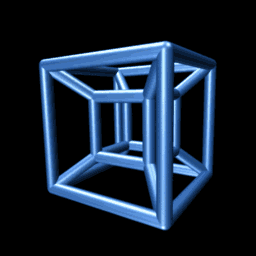A rotating two-dimensional projection of the four-dimensional tesseract. The projection appears to change as it rotates even though the four-dimensional polytope is symmetrical because it is warped by the loss of two dimension. Credit: Wikimedia Commons
The curious child of bookish parents who browses through their libraries sometimes falls down a rabbit hole while apparently reading quietly in an armchair.
Something like this happened to Ivan Horozov, PhD, the William Chauvenet lecturer in the Department of Mathematics in Arts & Sciences at Washington University in St. Louis. Horozov grew up in Sofia, Bulgaria, the child of a mathematician whose library included the book "Geometry and the Imagination" by Hilbert and Cohn-Vossen.
The book, which he says reads like a storybook rather than a textbook, explores regular geometric shapes—which mathematicians call polytopes—in two, three and four spatial dimensions.
A square is a two-dimensional polytope; its three dimensional analog is a cube and its four-dimensional analog is something called a tesseract.
The book, of course, could only show two-dimensional projections of the three- or four-dimensional objects it described. For example, on the page the drawing of a cube was a square within a square.
To make three-dimensional models of the three-dimensional polytopes, Horozov constructed their polygonal faces with a straightedge and compass, cut them out and glued them together along their edges. In this way he made all five three-dimensional polytopes (the tetrahedron, cube, octahedron, dodecahedron and icosahedron).
Then he started on the four-dimensional polytopes. There are six of those, he learned.
"The book illustrated the four-dimensional analog of a tetrahedron, the four-dimensional analog of a cube, the four-dimensional analog of an octahedron and a four-dimensional poltyope that has no analog in other dimensions," Horozov said.
"The remaining two, it said, were too complicated to draw. So I decided if I could not draw them, I would at least imagine what the polytopes should look like.
It took me two years, but by the time I was 12 I could imagine the fifth four-dimensional polytope, which is made up of 120 dodecahedrons."
But he couldn't build it until he arrived in St. Louis to take a postdoctoral teaching position. Here he discovered Zometools, construction sets invented by a designer who was interested in polygonal buildings, like Buckminister Fuller's dome.
Horozov "assimilated" all of the Zomes in the mathematics department and began to build the 120-cell polytope. The finished model, a giant, gaily colored, weirdly distorted cobweb of balls and struts now occupies most of his office. It is just possible to close the door without brushing against it.
"Of course you can't throw away a dimension without losing information. The projection of a cube onto a sheet of paper is a square within a square, but the two squares are now ever so slightly distorted," Horozov said. In the case of the 120-cell polytope, the innermost dodecahedron is regular, but as you move outward form the center the dodecahedrons are more and more deformed.
Horozov is now working on the sixth four-dimensional polytope, which is, he said, the dual of the 120-cell polytope. A dual is the figure that emerges when the vertices of one figure become the faces of another and the faces the vertices. The dual of a cube, for example, is an octahedron. And the dual of the polytope made of 120 dodecahedrons is a polytope made of 600 tetrahedrons.
Even the Greeks knew about the three-dimensional polytopes, often called Platonic solids. But the four-dimensional polytopes were discovered only in the 19th century and even then the mathematician who described them was unable to get his work published because it was considered so outlandish.
After all it isn't intuitive that there might be more than three spatial dimensions. Perhaps this is why magical properties have been ascribed to the four-dimensional polytopes. In Madeleine d'Engle's "Wrinkle in Time," for example, the tesseract is a time-travel device that wrinkles up the space-time continuum and creates a passage from one part of it to another.
Horozov hasn't read "A Wrinkle in Time," but he does follow string theory, theories in physics that predict there are extra dimensions. One version, for example, predicts spacetime has 11 dimensions and that we just don't see anything except the three spatial dimensions and time because the extra dimensions are "compactified," or rolled up tight.
String theory, like the four-dimensional polytopes, is still very much an imaginative exercise, but should experimental evidence of its validity ever surface, we will all have to cultivate multi-dimensional thinking.
Provided by Washington University in St. Louis






















